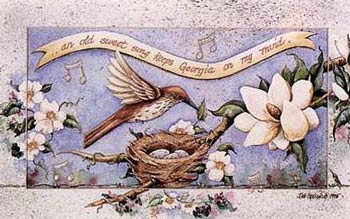Colonial
Georgia
Georgia
History 101
by Col. Samuel
Taylor U.S.M.C. (Ret.)
The colony of Georgia was truly
the vision of
James Edward Oglethorpe. His plan to use the new colony as a haven for
people in debtors prison grew out of his committee work while a member of
Parliament. Although Oglethorpe did not conceive the idea, he did seize it and
attempted to act upon it. However, by the time he received the charter for
Georgia (June 9, 1732) Oglethorpe had dropped his plan to use debtors and
hand-selected the
116 men and
women who would travel to South Carolina on The Ann.
On February 12, 1733 (February 1, old style) a group of six
small ships landed at Yamacraw Bluffs and set up on a site Oglethorpe had chosen
earlier. It would become
Savannah.
Defense was an early concern of the new colony. Oglethorpe established a
perimeter around the colony including Fort Augusta, Fort Fredrica and Fort St.
Simon (List of
Georgia forts) and had slavery and liquor banned from the colony.
Over the first six years the struggles of the new colony came
from inside. Many did not like the lack of land ownership; others were angry
over the lack of slaves; some just wanted rum and beer. Slavery was an extremely
divisive issue, with the people of Savannah wanting Negroes while the
Highlanders along the coast and the Saltzburgers at Ebenezer wanting to be
slave-free.
Georgia had always been a "melting pot," welcoming the
persecuted and prosecuted of Europe including large groups of Puritans,
Lutherans, and Quakers (Wrightsboro). The only group not welcome in Georgia were
Catholics, which is not surprising considering the religious wars that were
fought a century earlier in England. The diversity of religion brought Georgia
an unexpected strength - an willingness to accept others regardless of religion.
The first test of the new colony came in 1739 during the War
of Jenkins Ear. Southern Georgia and Florida were battlegrounds over the next
four years, most notably the siege of St. Augustine (1740) and the Battle of
Bloody Marsh (1742). When peace finally settled on the colony Oglethorpe was
gone, never to return, and William Stevens was president.
The War of Jenkins Ear was a minor war that fueled a much
larger conflict known as the War of Austrian Succession (1742-1748). Because of
the cost involved in fighting the war the English Parliament had little money to
support the colonies it helped fund over the past 80 years. Georgia came under
increasing pressure in the late 1740's to become self-sufficient.
Georgia was not prosperous under the trustee system. In 1749,
16 years into the trustee system, the colony exported goods for the first time.
James Habersham petitioned for slavery to be allowed and the request was granted
the following year.
In 1752 the trustees returned the colony to the king,
unwilling to continue for the entire 21 years stated in the charter. In 1754
John Reynolds arrives as first "royal governor," appointed by King George II and
in charge of the colony whose major products are naval stores, indigo and
lumber. Rice was a popular crop along coast; further inland they grew wheat and
other products whose hulls needed to be "cracked" before use, hence "Cracker," a
derogatory name for poor upcountry farmers.
Reynolds did not like Savannah and tried to move the capitol
south to Hardwicke, near Genesis Point on the Ogeechee River. This was one of
many unpopular moves that led to his ouster at the request of the colonists. He
was followed by Lieutenant Governor Henry Ellis, who disdained the state because
of its heat. Although the state was spared major battles during the French and
Indian War (1754-1763) it did reap a major benefit from the conflict: its
borders increased dramatically.
It was during the war that James Wright (Ellis' Lieutenant
Governor ) became Georgia's third and most well-liked of its royal governors.
Appointed by King George III, Wright proves to be capable as governor of
Georgia. He expanded the state's economy during his term and kept the Radicals
at bay well into the 1770's.

This
1745 map of Georgia shows the state extending west to the Mississippi. Only a
strip of land from Savannah to Augusta about 20 miles wide, along with some
small coastal communities had been settled by Europeans.
|
|
|
|
|
|
|
|
|
|
|
|
|
|
|
|
|
|
|
|
|
|
|
|
|
|
|
|
|
|
|
|

